Hybrid Woven Glass Fibre Fabric-Multi-Walled Carbon Nanotube-Epoxy Composites Under Low Rate Impact
Abstract
:1. Introduction
2. Materials and Methods
3. Results
3.1. Optimisation of the MWNT-Epoxy Electrospinning Process
3.2. Composite Laminates for Impact Testing
3.3. Impact Testing Results
4. Discussion
5. Conclusions
Author Contributions
Conflicts of Interest
References
- Sandler, J.K.W.; Kirk, J.E.; Kinloch, I.A.; Shaffer, M.S.P.; Windle, A.H. Ultra-low electrical percolation threshold in carbon-nanotube-epoxy composites. Polymer 2003, 44, 5893–5899. [Google Scholar] [CrossRef]
- Moudam, O.; Andrews, T.; Lekakou, C.; Watts, J.F.; Reed, G.T. Carbon nanotube-epoxy nanocomposites: Correlation and integration of dynamic impedance, dielectric and mechanical analyses. J. Nanomater. 2013, 801850. [Google Scholar] [CrossRef]
- Rebord, G.; Hansrisuk, N.; Lindsay, B.; Lekakou, C.; Reed, G.T.; Watts, J.F. Electrofunctional nanocomposites. In Proceedings of the 2nd Electronics System-Integration Technology Conference, Greenwich, UK, 1–4 September 2008; pp. 1401–1405. [Google Scholar]
- Ogasawara, T.; Ishida, Y.; Ishikawa, T.; Yokota, R. Characterisation of multi-walled carbon nanotubes/phenylethynyl terminated polyimide composites. Compos. A Appl. Sci. Manuf. 2004, 35, 67–74. [Google Scholar] [CrossRef]
- Tai, N.H.; Yeh, M.K.; Liu, J.H. Enhancement of the mechanical properties of carbon nanotube/phenolic composites using a carbon nanotube network as the reinforcement. Carbon 2004, 42, 2774–2777. [Google Scholar] [CrossRef]
- Gojny, F.H.; Wichmann, M.H.G.; Köpke, U.; Fiedler, B.; Schulte, K. Carbon nanotube-reinforced epoxy-composites: Enhanced stiffness and fracture toughness at low nanotube content. Compos. Sci. Technol. 2004, 64, 2363–2371. [Google Scholar] [CrossRef]
- Hull, D.; Shi, Y.B. Damage mechanism characterisation in composite damage tolerance investigations. Compos. Struct. 1993, 23, 903–915. [Google Scholar] [CrossRef]
- Zhou, G.; Davies, G.A.O. Impact response of thick glass fibre reinforced polyester laminates. Int. J. Impact Eng. 1997, 17, 357–374. [Google Scholar] [CrossRef]
- Tong, L.; Mourittz, A.P.; Bannister, M.K. 3D Fiber Reinforced Composites; Elsevier: Boston, MA, USA, 2002; pp. 1–12. ISBN 9780080439389. [Google Scholar]
- Hojo, M.; Ando, T.; Tanaka, M.; Adachi, T.; Ochiai, S.; Endo, Y. Modes I and II interlaminar fracture toughness and fatigue delamination of CF/epoxy laminates with self-same epoxy interleaf. Int. J. Fatigue 2006, 28, 1154–1165. [Google Scholar] [CrossRef]
- Tsantzalis, S.; Karapappas, P.; Vavouliotis, A.; Tsotra, P.; Kostopoulos, V.; Tanimoto, T.; Friedrich, K. On the improvement of toughness of CFRPs with resin doped with CNF and PZT particles. Compos. A Appl. Sci. Manuf. 2007, 38, 1159–1162. [Google Scholar] [CrossRef]
- Iqbal, K.; Khan, S.U.; Munir, A.; Kim, J.K. Impact damage resistance of CFRP with nanoclay-filled epoxy matrix. Compos. Sci. Technol. 2009, 69, 1949–1957. [Google Scholar] [CrossRef]
- Khan, S.U.; Iqbal, K.; Munir, A.; Kim, J.K. Quasi-static and impact fracture behaviors of CFRPs with nanoclay-filled epoxy matrix. Compos. A Appl. Sci. Manuf. 2011, 42, 253–264. [Google Scholar] [CrossRef]
- Siddiqui, N.A.; Woo, R.S.C.; Kim, J.K.; Leung, C.C.K.; Munir, A. Mode I interlaminar fracture behaviour and mechanical properties of CFRPs with nanoclay-filled epoxy matrix. Compos. A Appl. Sci. Manuf. 2007, 38, 449–460. [Google Scholar] [CrossRef]
- Hsieh, T.H.; Kinloch, A.J.; Taylor, A.C.; Sprenger, S. The effect of silica nanoparticles and carbon nanotubes on the toughness of a thermosetting epoxy polymer. J. Appl. Polym. Sci. 2011, 119, 2135–2142. [Google Scholar] [CrossRef]
- Mohanty, A.K.; Wibowo, A.; Misra, M.; Drzal, L.T. Development of renewable resource-based cellulose acetate bioplastic: Effect of process engineering on the performance of cellulosic plastics. Polym. Eng. Sci. 2003, 43, 1151–1161. [Google Scholar] [CrossRef]
- Choi, J.S.; Lim, S.T.; Choi, H.J.; Hong, S.M.; Mohanty, A.K.; Drzal, L.T.; Misra, M.; Wibowo, A.C. Rheological, thermal, and morphological characteristics of plasticized cellulose acetate composite with natural fibers. Macromol. Symp. 2005, 224, 297–307. [Google Scholar] [CrossRef]
- Rahimzadeh, T.; Arruda, E.M.; Thouless, M.D. Design of armor for protection against blast and impact. J. Mech. Phys. Solids 2015, 85, 98–111. [Google Scholar] [CrossRef]
- Ma, P.; Kim, J. Carbon Nanotubes for Polymer Reinforcement; Taylor & Francis Group: Boca Raton, FL, USA, 2011; ISBN 9781439826269. [Google Scholar]
- Khan, S.U.; Kim, J.K. Impact and delamination failure of multiscale carbon nanotube-fiber reinforced polymer composites: A review. Int. J. Aeronaut. Space Sci. 2011, 12, 115–133. [Google Scholar] [CrossRef]
- Lekakou, C.; Kontodimopoulos, I.; Murugesh, A.K.; Jesson, D.A.; Watts, J.; Smith, P.A. Processability studies of silica-thermoset polymer matrix nanocomposites. Polym. Eng. Sci. 2008, 48, 216–222. [Google Scholar] [CrossRef] [Green Version]
- Karapappas, P.; Vavouliotis, A.; Tsotra, P.; Kostopoulos, V.; Paipetis, A. Enhanced fracture properties of carbon reinforced composites by the addition of multi-wall carbon nanotubes. J. Compos. Mater. 2009, 43, 977–985. [Google Scholar] [CrossRef]
- Kostopoulos, V.; Baltopoulos, A.; Karapappas, P.; Vavouliotis, A.; Paipetis, A. Impact and after-impact properties of carbon fibre reinforced composites enhanced with multi-wall carbon nanotubes. Compos. Sci. Technol. 2010, 70, 553–563. [Google Scholar] [CrossRef]
- Inam, F.; Wong, D.W.Y.; Kuwata, M.; Peijs, T. Multiscale hybrid micro-nanocomposites based on carbon nanotubes and carbon fibers. J. Nanomater. 2010, 453420. [Google Scholar] [CrossRef]
- Wan Hanif, W.Y.; Risby, M.S.; Noor, M.M. Influence of carbon nanotube inclusion on the fracture toughness and ballistic resistance of twaron/epoxy composite panels. Procedia Eng. 2015, 114, 118–123. [Google Scholar] [CrossRef]
- Grujicic, M.; Pandurangan, B.; Koudela, K.L.; Cheeseman, B.A. Ballistic-performance optimization of a hybrid carbon-nanotube/E-glass reinforced poly-vinyl-ester-epoxy-matrix composite armor. Appl. Surf. Sci. 2007, 42, 5347–5359. [Google Scholar] [CrossRef]
- Zhao, X.; Koos, A.A.; Chu, B.T.T.; Johnston, C.; Grobert, N.; Grant, P.S. Spray deposited fluoropolymer/multi-walled carbon nanotube composite films with high dielectric permittivity at low percolation threshold. Carbon 2008, 47, 561–569. [Google Scholar] [CrossRef]
- Palazzetti, R. Electrospun Nanofibrous Interleaves in Composite Laminate Materials. Ph.D. Thesis, University of Bologna, Bologna, Italy, 2012. [Google Scholar]
- Shenoy, S.L.; Bates, W.D.; Frisch, H.L.; Wnek, G.E. Role of chain entanglements on fiber formation during electrospinning of polymer solutions: Good solvent, non-specific polymer-polymer interaction limit. Polymer 2005, 46, 3372–3384. [Google Scholar] [CrossRef]
- Zhong, X.; Kim, K.; Fang, D.; Ran, S.; Hsiao, B.S.; Chu, B. Structure and process relationship of electrospun bioabsorbable nanofiber membranes. Polymer 2002, 43, 4403–4412. [Google Scholar] [CrossRef]
- Saunders, R.A.; Lekakou, C.; Bader, M.G. Compression in the processing of polymer composites 1. A mechanical and microstructural study for different glass fabrics and resins. Compos. Sci. Technol. 1999, 59, 983–993. [Google Scholar] [CrossRef]
- Liu, L.; Liang, Y.; Xu, G.; Zhang, H.; Huang, Z.M. Mode I interlaminar fracture of composite laminates incorporating with ultrathin fibrous sheets. J. Reinf. Plast. Compos. 2008, 27, 1147–1162. [Google Scholar] [CrossRef]
- Salifu, A.A.; Nury, B.D.; Lekakou, C. Electrospinning of nanocomposite fibrillar tubular and flat scaffolds with controlled fiber orientation. Ann. Biomed. Eng. 2011, 39, 2510–2520. [Google Scholar] [CrossRef] [PubMed] [Green Version]
- Hirai, Y.; Hiroyuki, H.; Kim, J.K. Damage modes in impact loading of glass woven fabric composites. Adv. Compos. Lett. 1996, 5, 56–60. [Google Scholar]
- Belingardi, G.; Vadori, R. Low velocity impact tests of laminate glass-fiber-epoxy matrix composite material plates. Int J. Impact Eng. 2002, 27, 213–229. [Google Scholar] [CrossRef]
- Lekakou, C.; Wilson, P.; Craggs, D.; Chau, Y.C.; Salifu, A.A.; Chen, Y.L.; Watts, J.F. Electrospinning of polymer nanocomposites. In Proceedings of the 17th International Conference on Composite Materials, Edinburgh, UK, 27–31 July 2009. [Google Scholar]
- Rama Subba Reddy, P.; Sreekantha Reddy, T.; Madhu, V.; Gogia, A.; Venkateswara Rao, K. Behavior of E-glass composite laminates under ballistic impact. Mater. Des. 2015, 84, 79–86. [Google Scholar] [CrossRef]
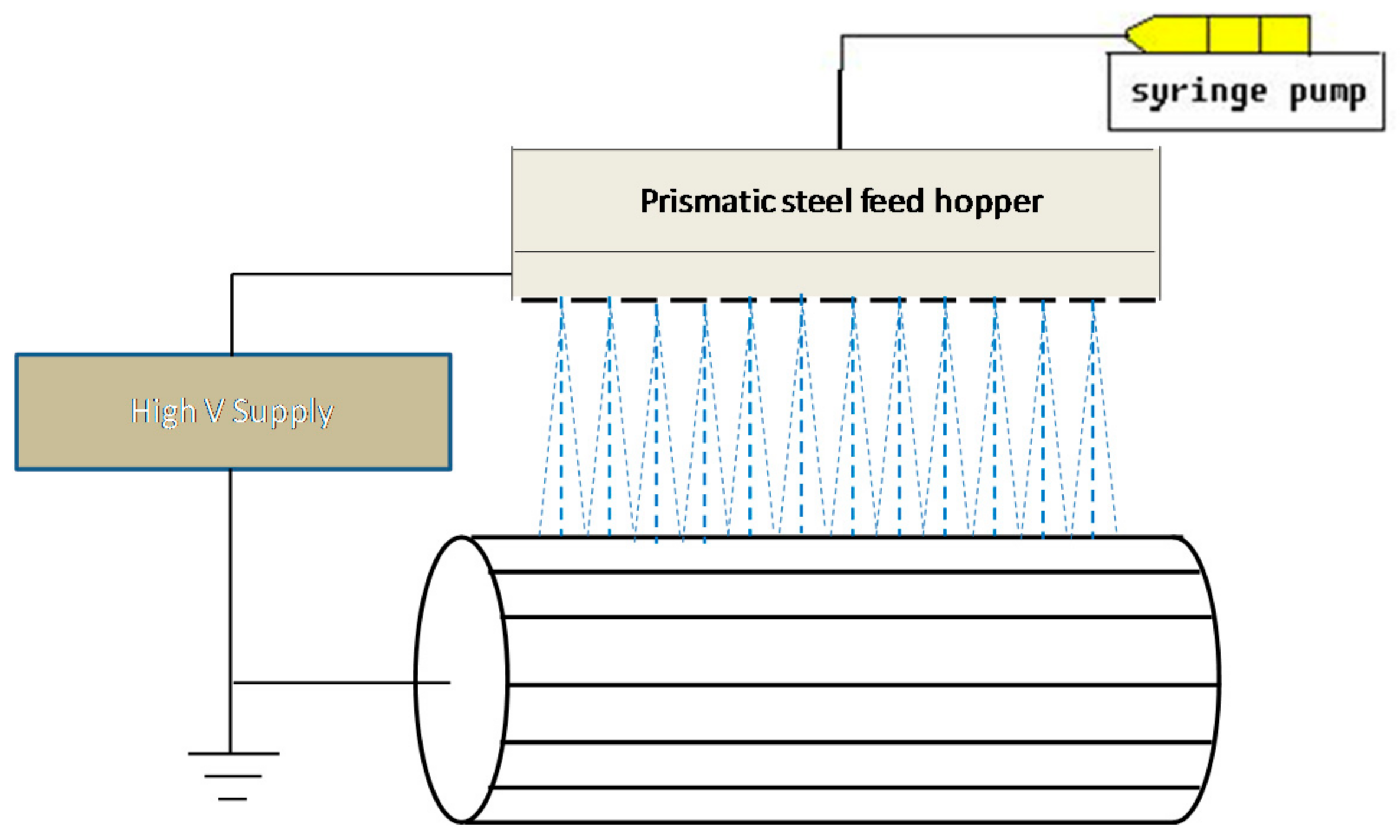
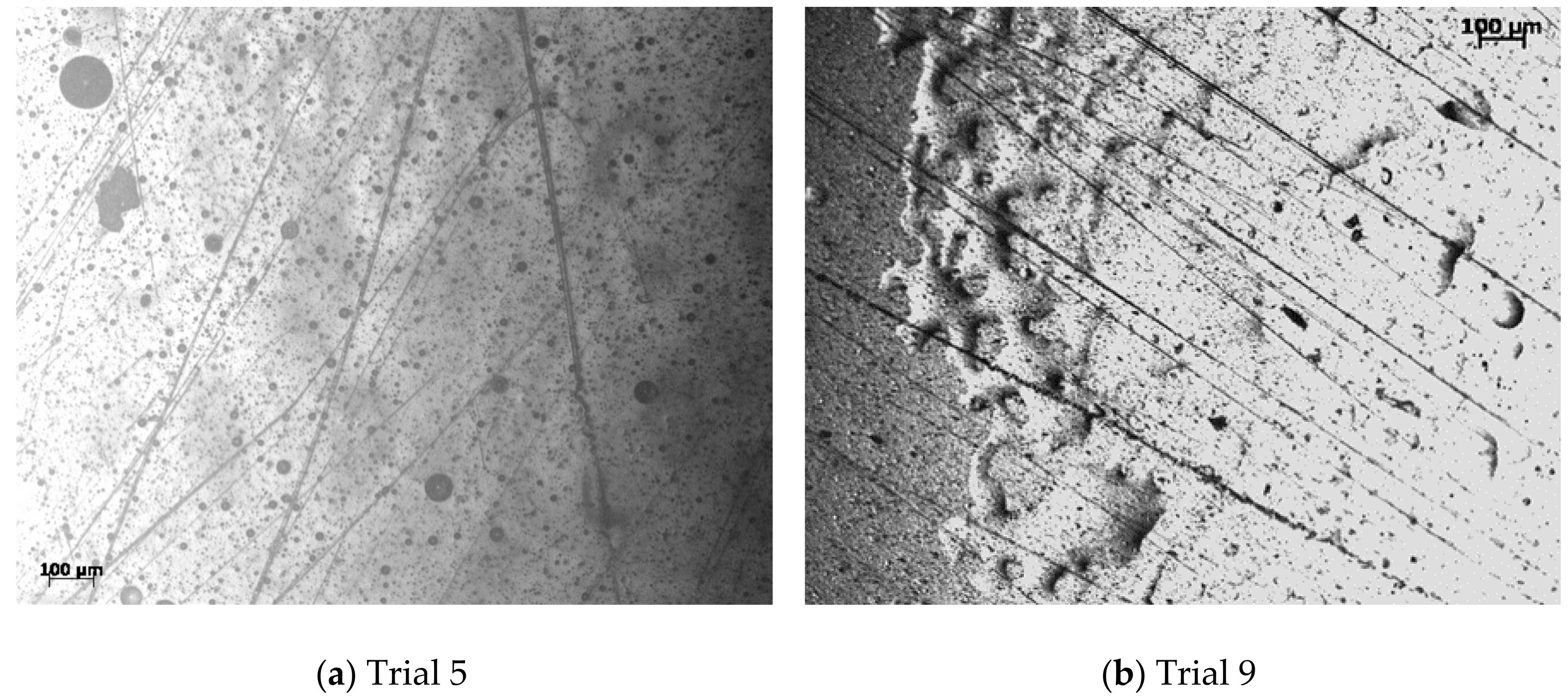

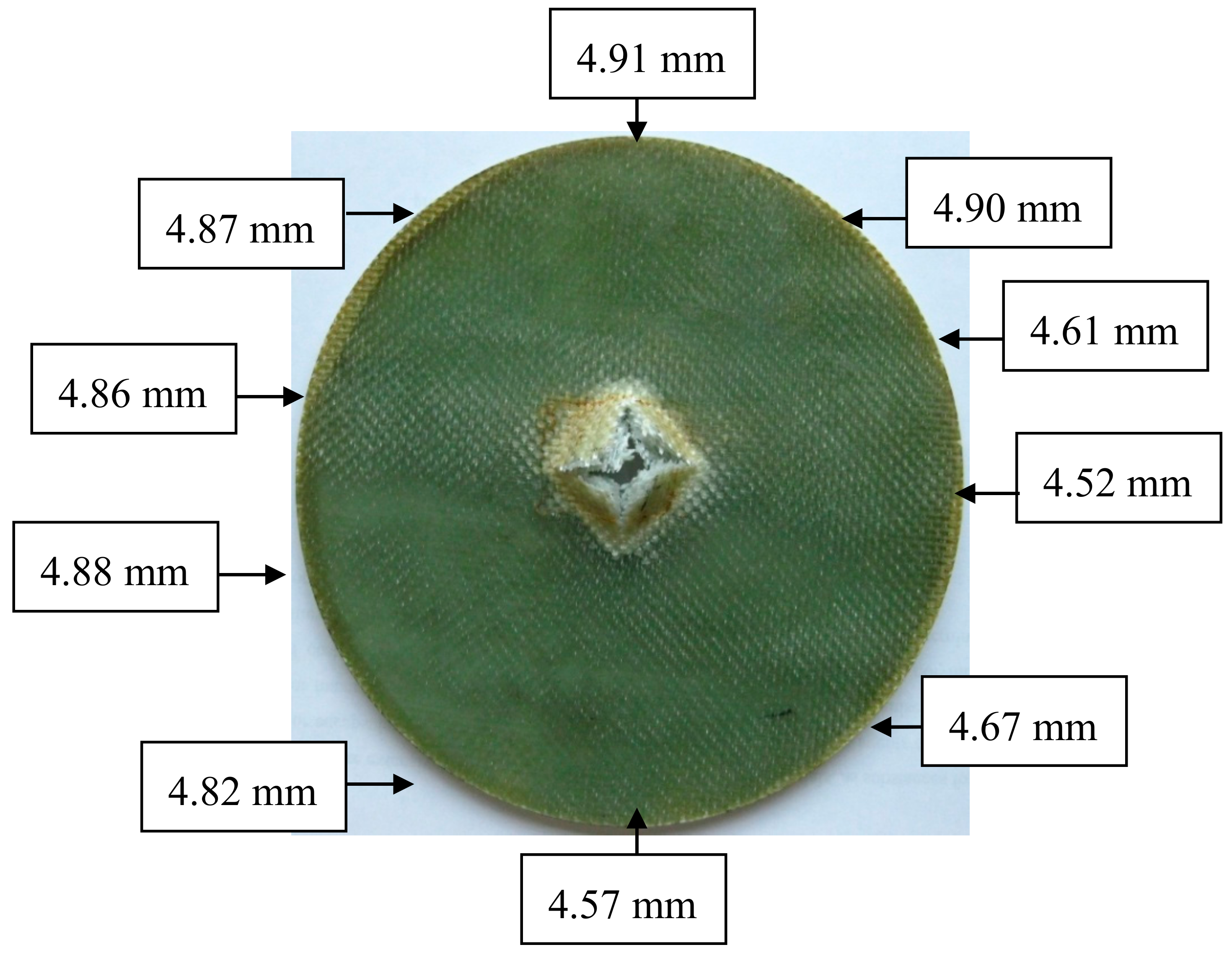

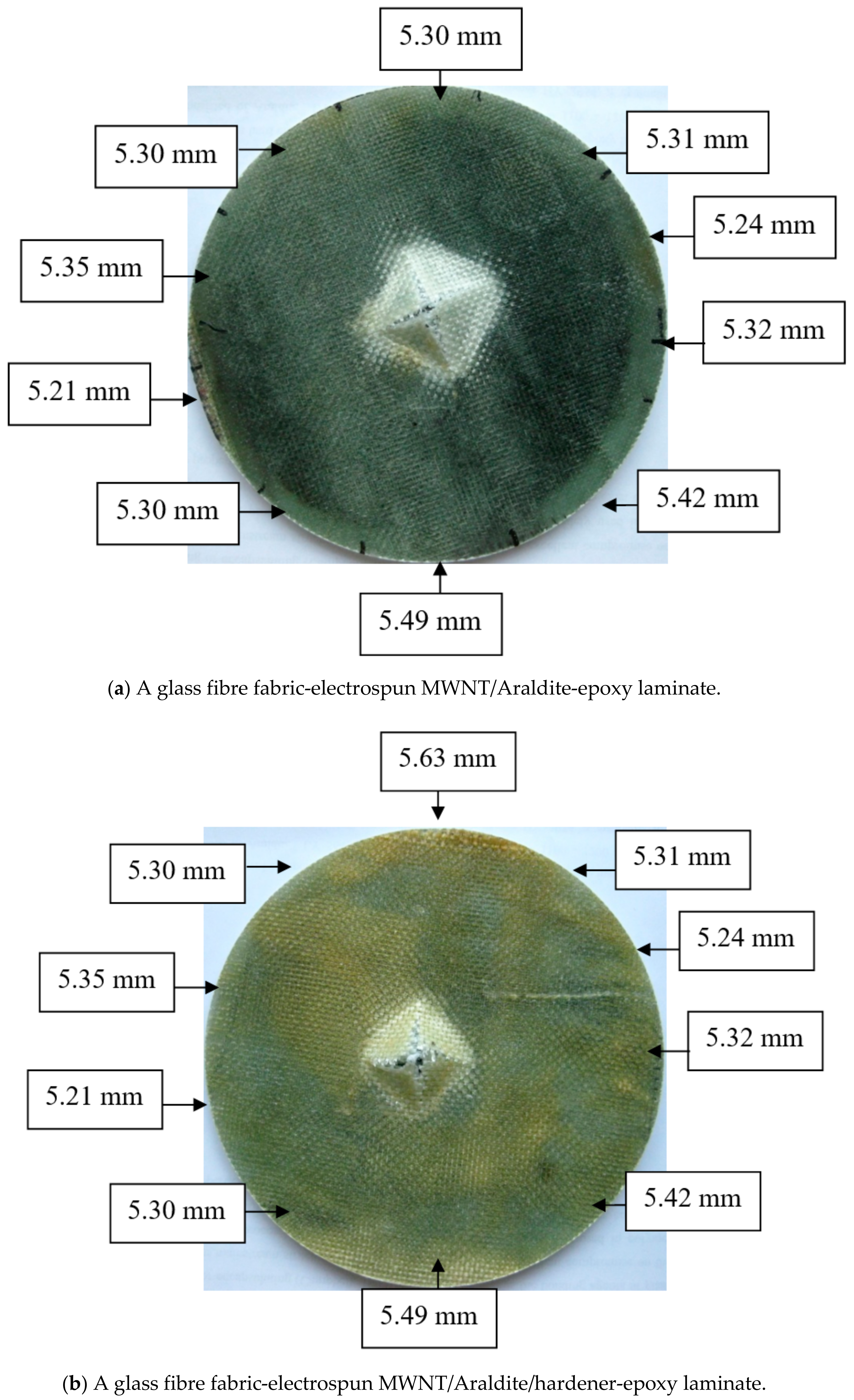

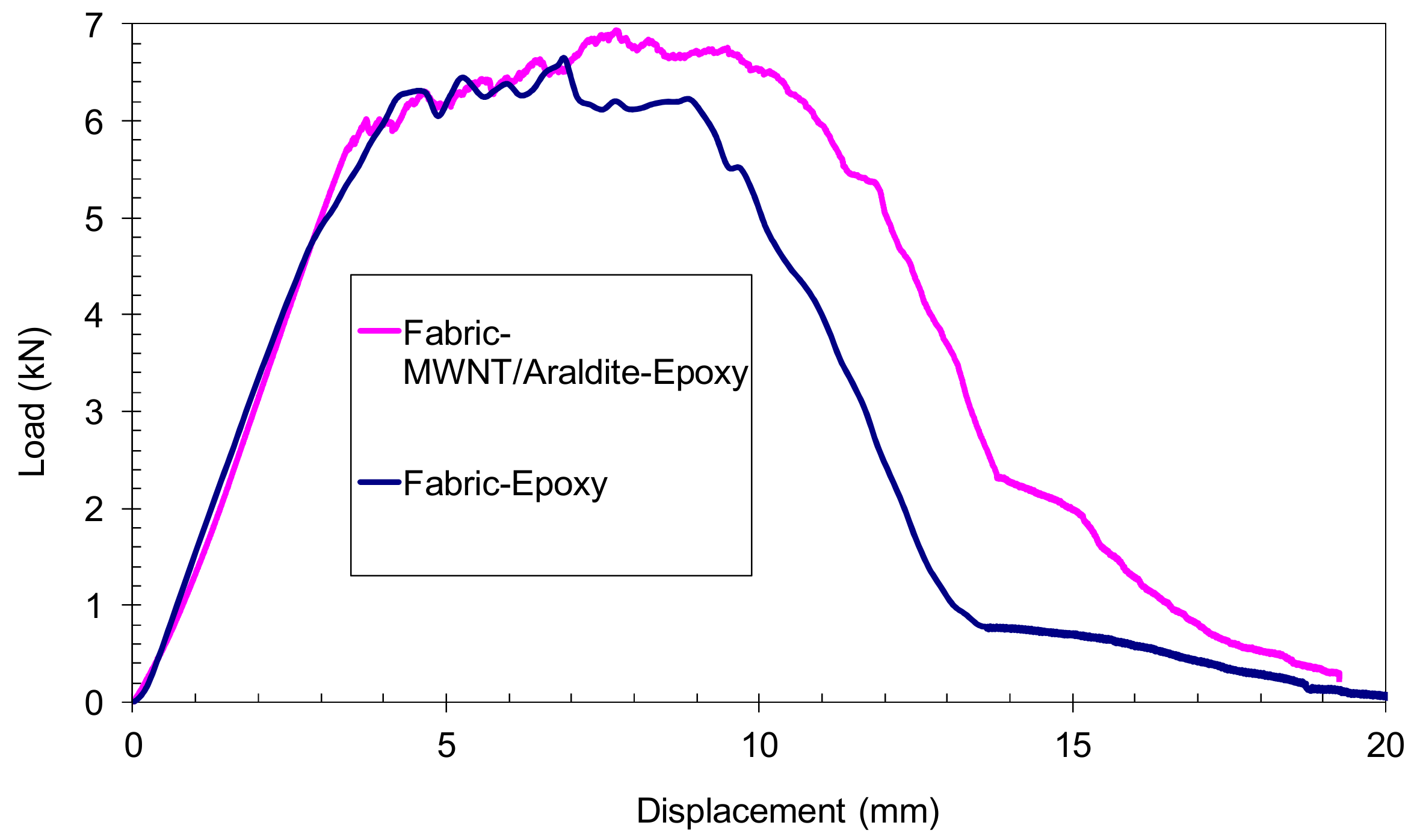
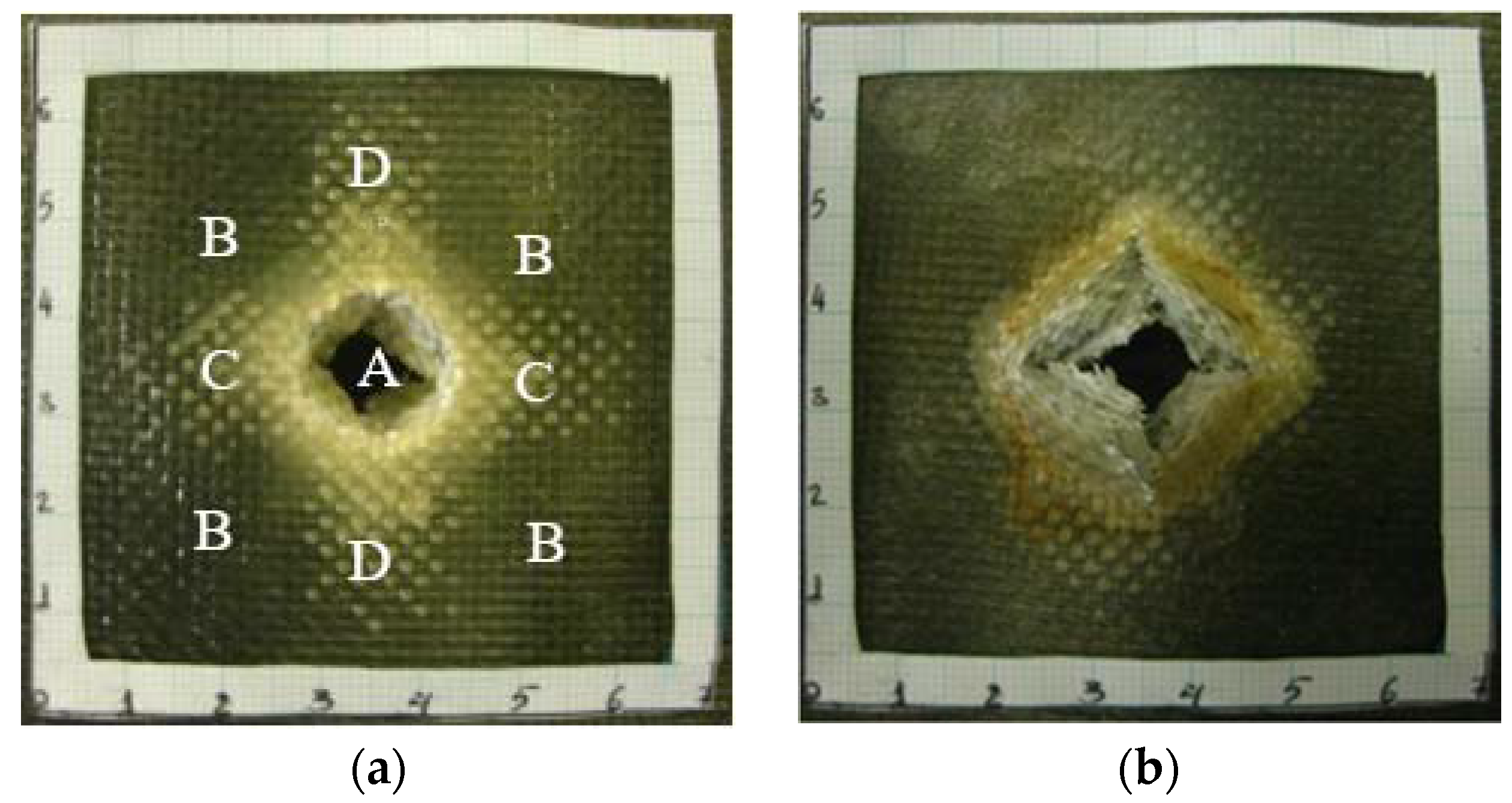
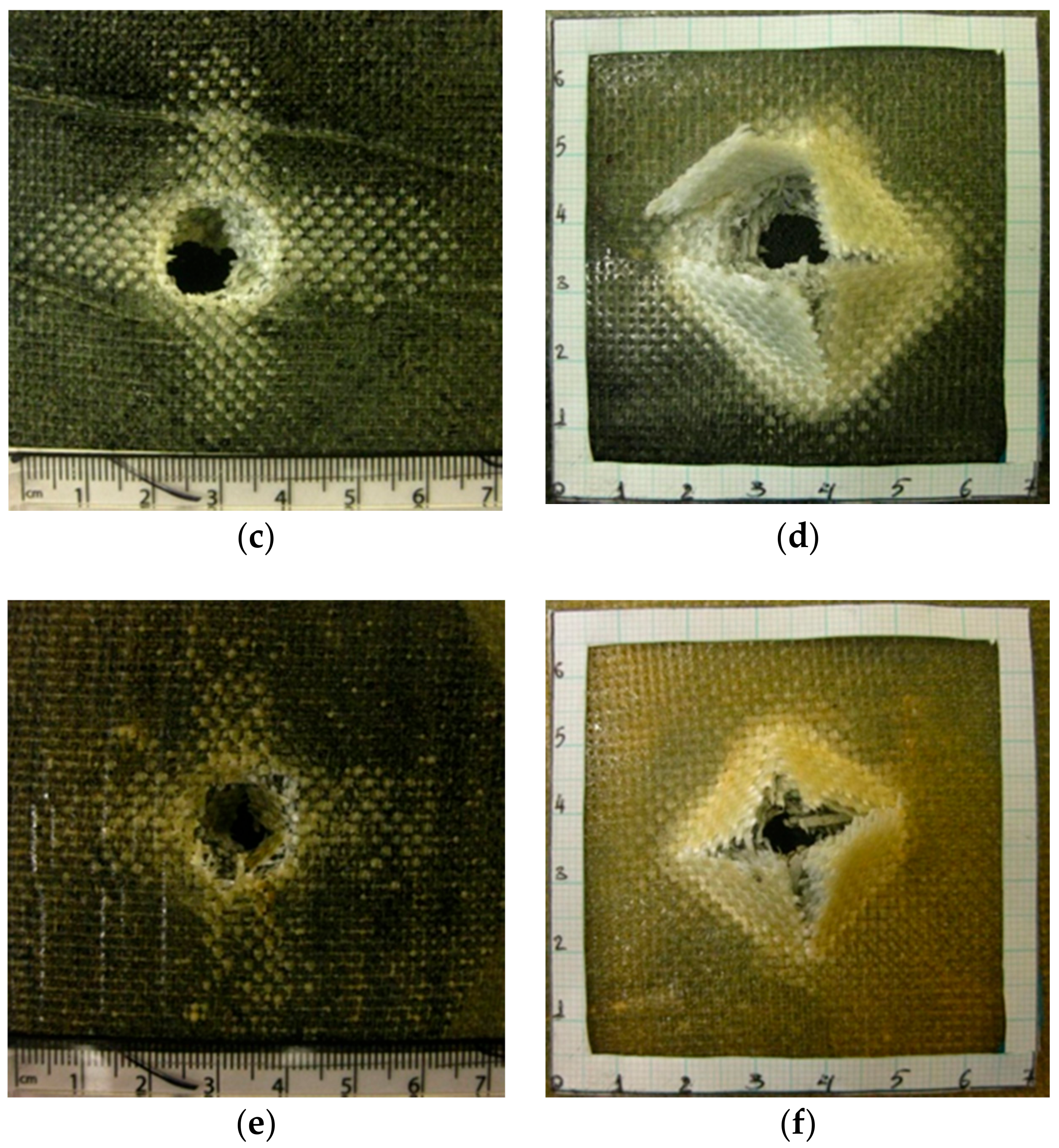
| Number of Trial | Material composition (mL) | Flow rate (mL/hr) | Duration (min) | Microstructure description | ||
|---|---|---|---|---|---|---|
| MWNT solution | Araldite | Hardener | ||||
| 1 | 10 | 1.695 | 0.805 | 27 | 10 | Spray only |
| 2 | 10 | 10 | 3.5 | 27 | 15 | Big droplets and few nanofibres |
| 3 | 10 | 30 Epoxy 300 | 18.38 g MNA & 1.2 g K61 | 4 | 30 | Mostly fine spray and some big drops |
| 4 | 10 | 20 | - | 4 | 10 | Thick microfibres, small spray and big droplets |
| 5 | 10 | 10 | - | 4 | 10 | Fine spray, high concentration of nanofibres and some droplets |
| 6 | 5 | 7 | - | 4 | 15 | Spray and big islands. No nanofibres |
| 7 | 5 | 6 | - | 4 | 15 | Spray and small concentration of nanofibres |
| 8 | 5 | 2.5 | - | 4 | 15 | Some drops and small concentration of nanofibres |
| 9 | 10 | 10 | - | 4 | 10 | Some islands and high concentration of nanofibres |
| 10 | 5 | 5 | 1.5 | 4 | 5 | Big drops, some spray and low concentration of nanofibres |
| 11 | 5 | 8 | 2.8 | 4 | 5 | Fine spray and no nanofibres |
| 12 | 5 | 5.5 | 1.925 | 4 | 5 | Mostly fine spray and medium concentration of nanofibres |
| Laminates | Peak Load (kN) | Total Penetration Energy (J) | Real Damage Area (mm2) |
|---|---|---|---|
| Fabric-Epoxy | 6.6 ± 0.1 | 62.6 ± 2.4 | 1722 |
| Fabric-MWNT/Araldite/Hardener-Epoxy | 6.2 ± 0.2 | 65.8 ± 3.0 | 3215 |
| Fabric-MWNT/Araldite-Epoxy | 6.9 ± 0.1 | 76.6 ± 2.5 | 4225 |
© 2017 by the authors. Licensee MDPI, Basel, Switzerland. This article is an open access article distributed under the terms and conditions of the Creative Commons Attribution (CC BY) license (http://creativecommons.org/licenses/by/4.0/).
Share and Cite
Sadykov, D.; Nouicer, L.; Lekakou, C. Hybrid Woven Glass Fibre Fabric-Multi-Walled Carbon Nanotube-Epoxy Composites Under Low Rate Impact. J. Compos. Sci. 2017, 1, 10. https://doi.org/10.3390/jcs1010010
Sadykov D, Nouicer L, Lekakou C. Hybrid Woven Glass Fibre Fabric-Multi-Walled Carbon Nanotube-Epoxy Composites Under Low Rate Impact. Journal of Composites Science. 2017; 1(1):10. https://doi.org/10.3390/jcs1010010
Chicago/Turabian StyleSadykov, Daniyar, Lhadi Nouicer, and Constantina Lekakou. 2017. "Hybrid Woven Glass Fibre Fabric-Multi-Walled Carbon Nanotube-Epoxy Composites Under Low Rate Impact" Journal of Composites Science 1, no. 1: 10. https://doi.org/10.3390/jcs1010010




